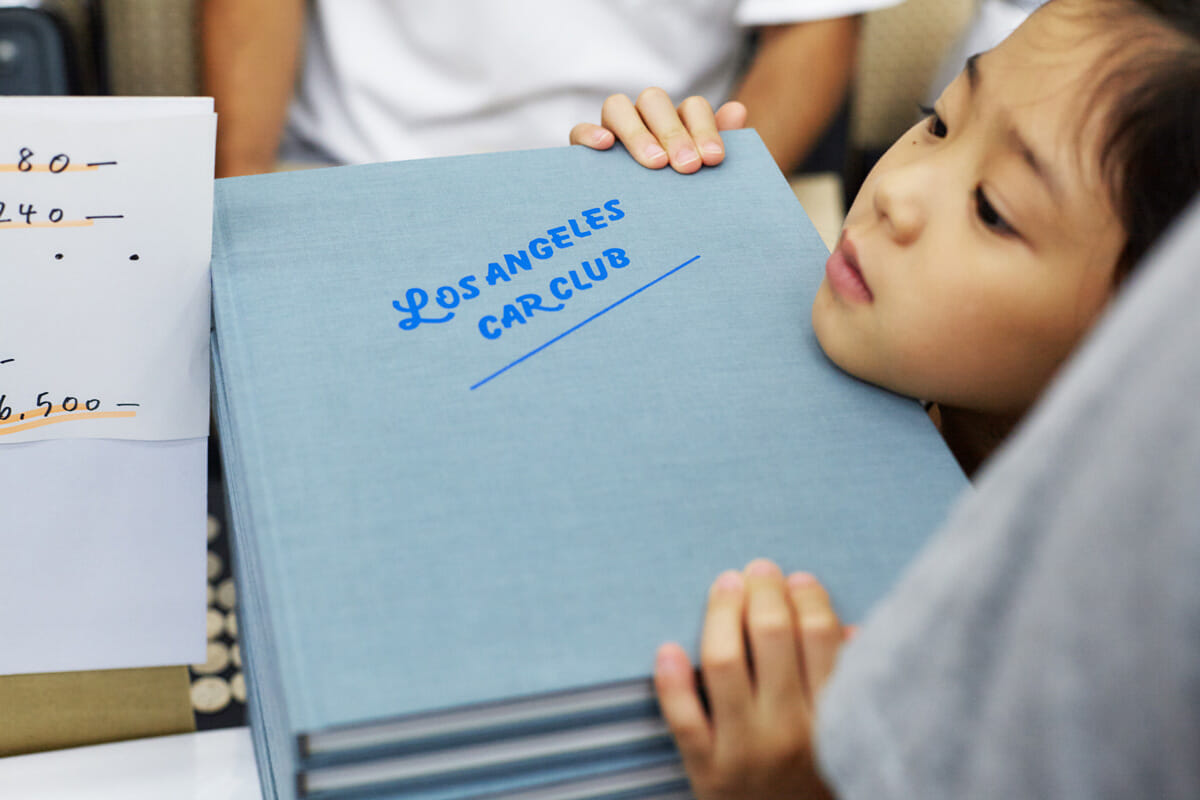
Inevitability and coincidence as captured in Los Angeles Car Club ("LACC").
Muraoka:I know that some people have already bought "LACC" and some are just getting started, but why did you decide to make it a voluntary project in the first place?
Plain:First of all, I have been taking pictures of these for 6 or 7 years. At first, I just wanted to take good pictures and thought it would be interesting to take pictures with this kind of composition, but gradually I began to think about how I could make use of them. Then I started to think about how I could make use of them. I thought it would be better to use it as a book than as an exhibition, because I could imagine it appearing more and more as I turned the pages.
Muraoka:Is it possible to formulate such an image? Did you not have the image of showing it in an exhibition?
Plain:Hmmm . . but I feel that the book has priority, and that's been the case for the last couple of years, during the latter half of the filming period. I think it's the book after all.
Muraoka:Did you take it as a photo without thinking about it later?
Plain:Yes. Then, when I decided to make a book, I had to think about what kind of book it would be. A book is an object, so I gradually think about what kind of presence I want it to have, and while I am thinking about that, I am also taking photographs at the same time. I gradually came to have a firm idea of what I wanted the book to be like, but when I took it to a publisher, the firm idea was bent. I had David from Dashwood Books in New York and Michael Mack from Mack's in England take a look at it. I never heard from Mack's again after that, though he looked at me favorably at the time. He was very kind to me at the time, but then he suggested that if Dashwood had this kind of shape, would you take it out of our house? But it was very different from the form of the book that I had been thinking about for a long time.
Muraoka:By the way, what kind?
Plain:It was a light book, about 48 pages, saddle-stitched. I thought, "That's not right," but it would take a lot of power to persuade a publisher, or to find a publisher who would publish it the way I wanted it to be published. I wanted to try to get it published by a foreign publisher. I tried to find such publishers, but I felt that negotiating with them in a language other than my own was very powerful, so I decided to publish the book myself. I had always wanted to self-publish a book someday. I had various ideas of publishing a book with a publisher that publishes photo books, such as Little More for "POOL," or a foreign publisher, or self-publishing a book and selling it myself. . Even though there is the money aspect, I can do it the way I want to do it. That is why I decided to self-publish.
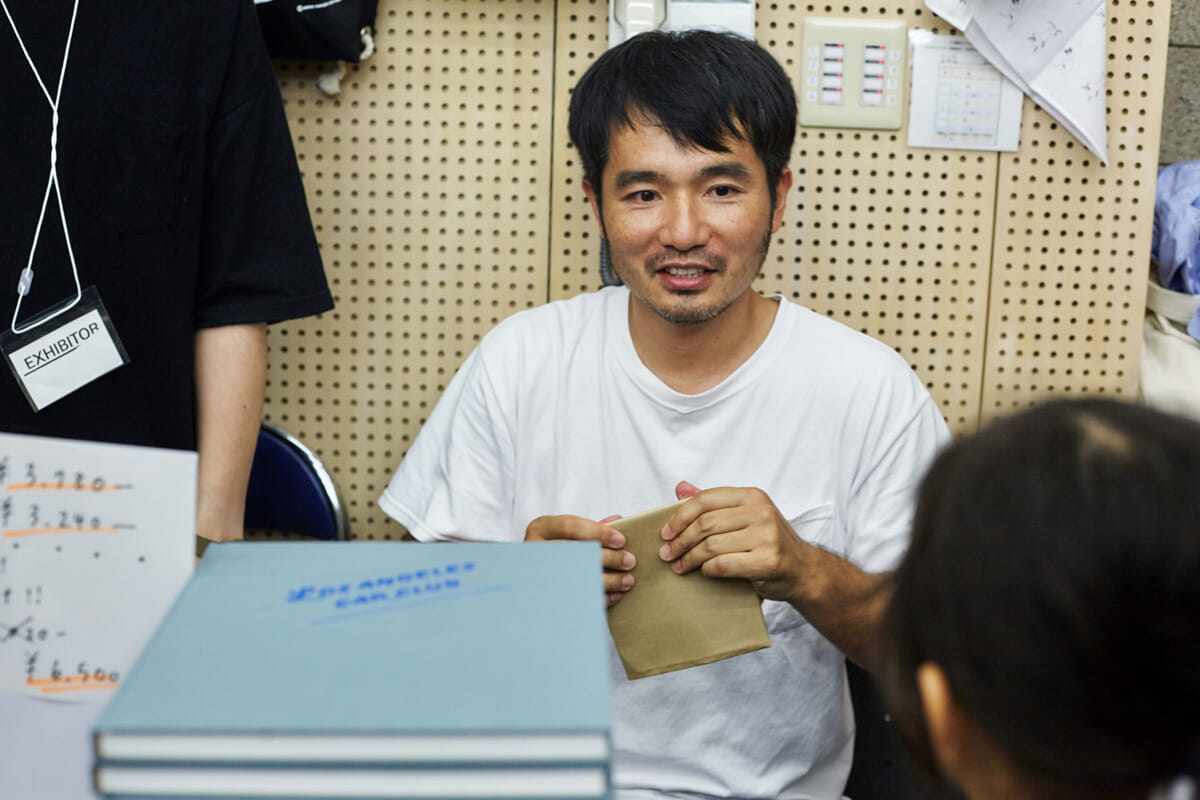
Muraoka:Do you choose designers, too, who can do it the way you want it done?
Plain:Yes. I would like a designer who can give me ideas that I could never have imagined. I wanted someone who would not just do what I wanted, but someone who would at least keep what I wanted, or at least go above and beyond. I consulted with Mr. Nakamura of Nakamura Graph and asked him to do it.
Muraoka:I know that in some cases, the order of the photos is left entirely up to the designer, but how did you handle that?
Plain:This time I did it on my end. It's really kind of like, it's divided into sections. . at first in pieces, then gradually into sedans, with the occasional sports car in between.
Muraoka:If you see it for the first time, you may think that there are really only cars in the picture! You might think, "Oh, it's really only cars in the picture! There are only cars in the picture.
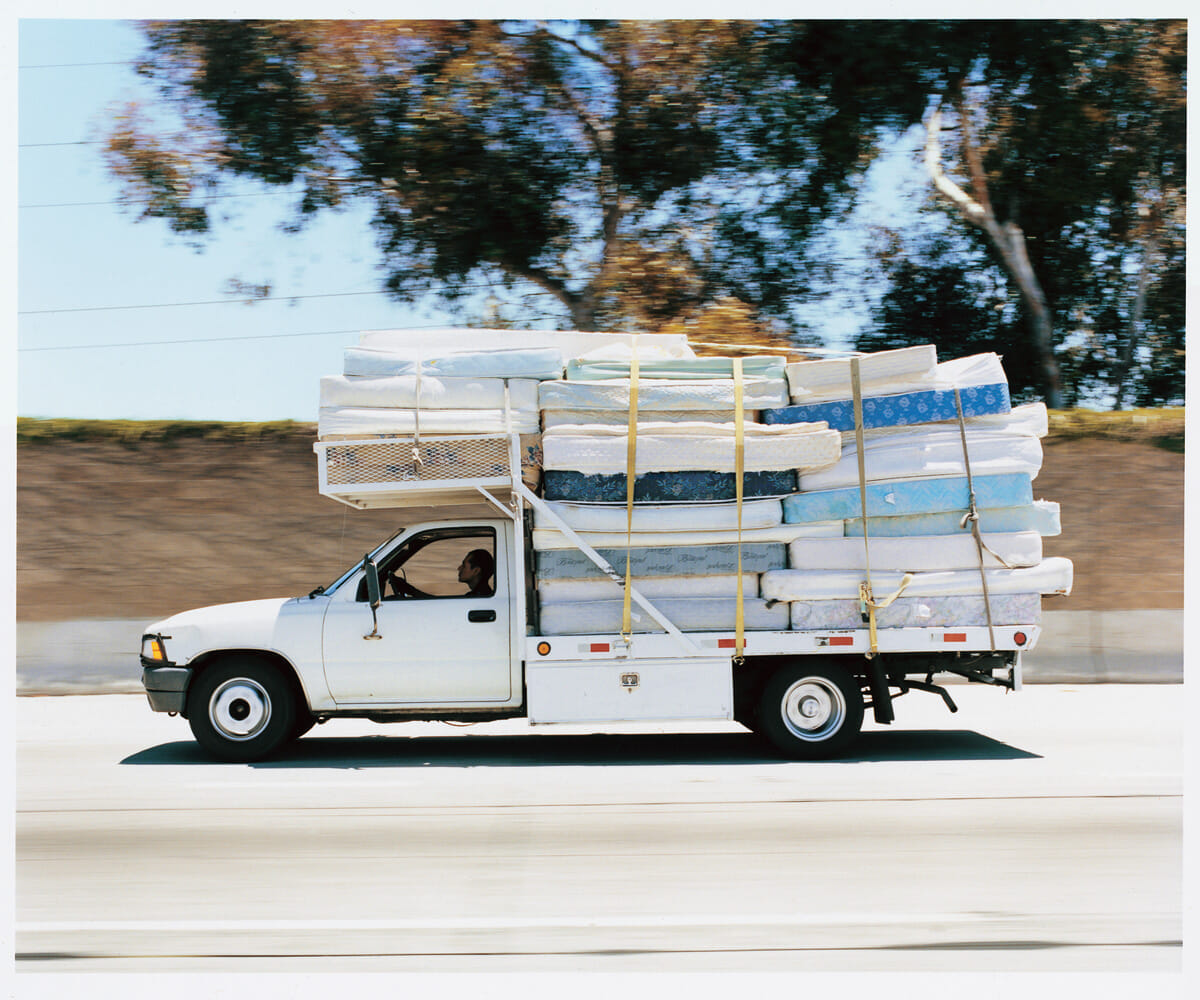
Plain:. and a working car. This is a mattress shop. Pickup trucks are not so common in Japan , so my eyes are drawn to them.
Muraoka:Now let's hear where and how this was taken in the first place.
Plain:The title of this album is "Los Angeles Car Club," so I limited it to Los Angeles. The reason why I limited it to Los Angeles is partly because I thought it would be a bit vague, and partly because I thought it might show the regional character of Los Angeles. The United States is a very large country, and there are many different forms of America, many of which I do not know, but Los Angeles is the one I know the most about. If you ask me if I like L.A. the best, I am not sure, but it is a place I often go to for some reason or another. The sunlight and the freeway feel like Los Angeles to me.
Muraoka:Is this on a Pentax 67?
Plain:Yes, it is.
Muraoka:While driving?
Plain:Yes . I'm in the passenger seat, filming from inside the car, but I had someone else drive. I couldn't take this picture without having someone else drive.
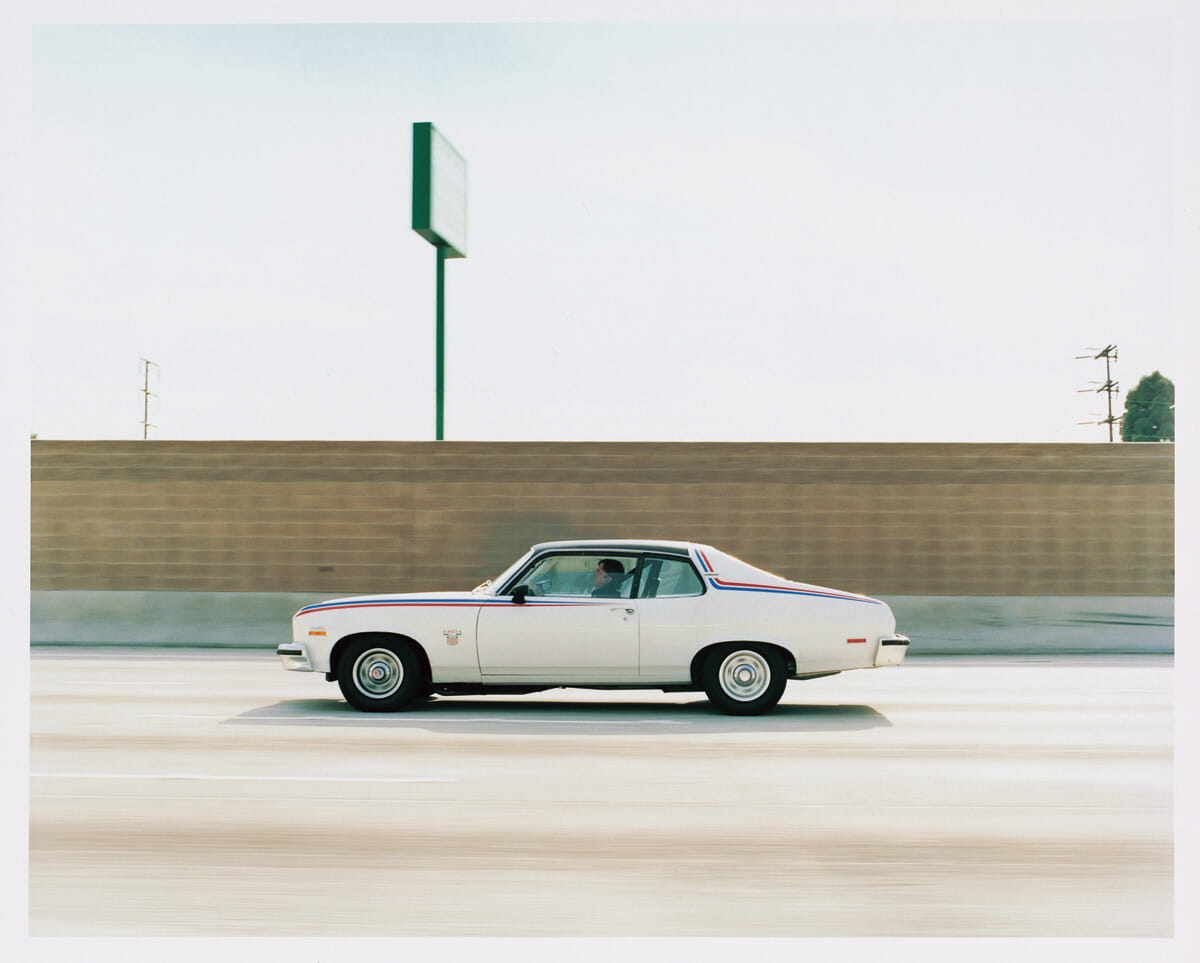
Muraoka:If you're driving around and see something that looks interesting, you're like, "Go"?
Plain:. yes, yes. If I see a car in the distance that looks interesting, I speed up a little and follow it, and if it looks good, I drive alongside it. If it looked good, I would drive alongside it. I would open the glass window and hold the camera with my hand. . This one was shaking, that one was shaking, but I didn't want to make it blurry. . But I wanted the background to look speedy and blurry. I kept the shutter speed at 1/125th, but if it was faster, the background would stop, and if it was slower, the car would be blurred, so I set the aperture to that level for most of the shots. I was selling "LACC" today, and people kept asking me, "Did you stop to take this picture? I was selling "LACC" today, and people kept asking me, "Are you stopping to take pictures?
Muraoka:It is quite difficult to get a good view from the side. When this was published, there was talk of "both necessity and coincidence in the picture," where necessity is the car as the subject I want to photograph, and coincidence is the fact that I cannot choose the background.
Plain:Taka Kawachi, one of the directors of the Tokyo Art Book Fair, pointed this out to me, and I realized that since I was driving at speeds of 100 km/h, there was really no time to press the button when the car was right on top of me, in focus and ready to go! Sometimes I only get one shot, and sometimes I get so many shots that if I get five, it means I got a lot of shots, so I can't choose the background. . I thought to myself, "I've never taken many pictures where I didn't have to choose the background. . the car model is a necessity, something you want to photograph, but the background is a coincidence, random. When I look at the background, I see that I have taken pictures in places where no one would take a picture. I think that's a big part of it.
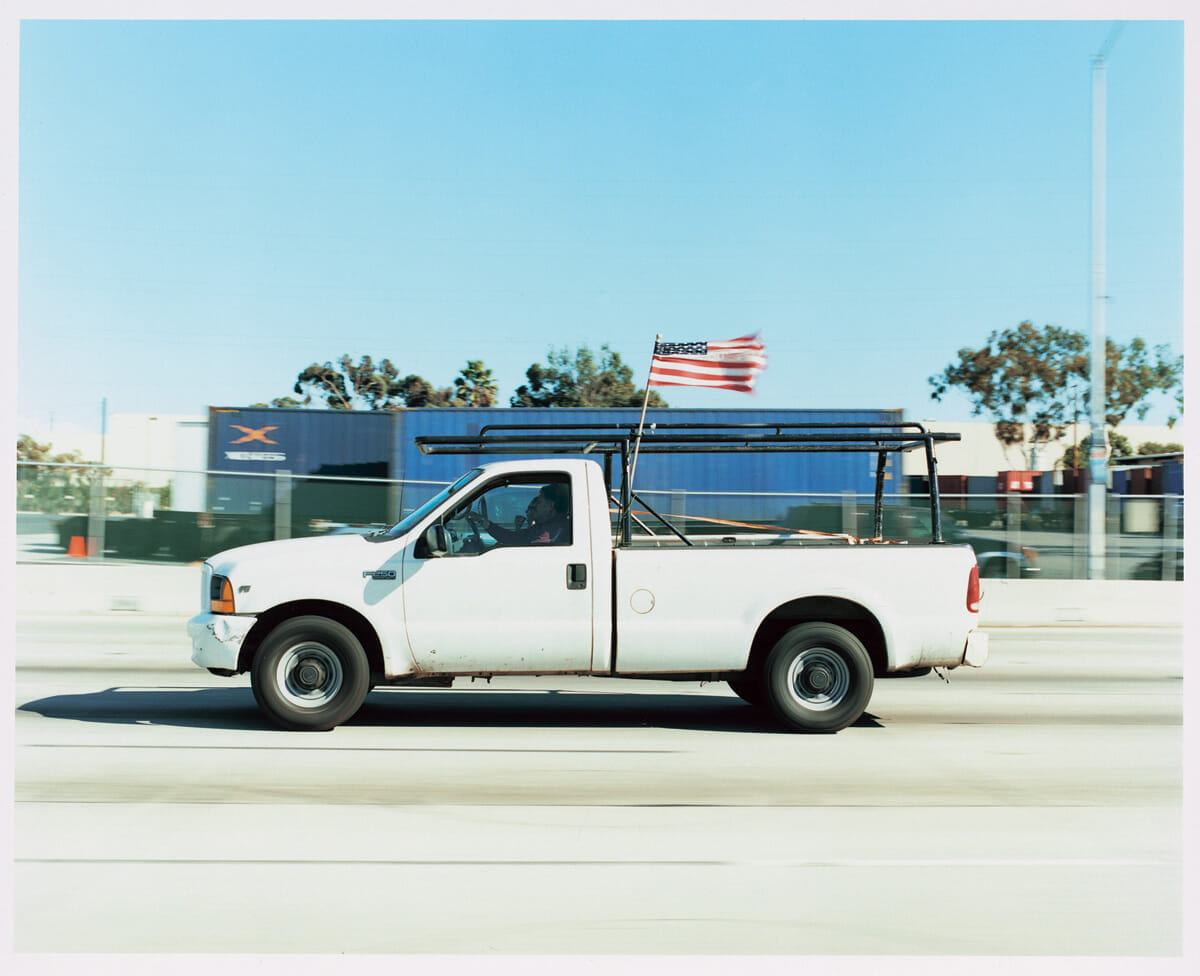
Muraoka:What is this American flag looking thing?
Plain:That's what I do when I'm in the select stage and I'm taking four or five pictures, and if I see a star-spangled banner or a palm tree in the picture, I say, "Oh! Delicious!" And I'm choosing them. Well, I choose them after I take the pictures.
Muraoka:. I think it's like a photograph in that there are letters in the picture, and you think about the meaning of the letters on your own. Isn't it difficult to get the horizon in this way?
Plain:Horizontal, it's tough. Sometimes it's pretty far to the right and sometimes it's down. I try to keep it as level as possible, but .
Muraoka:Wouldn't it be possible to make it horizontal at the time of printing, like an installer, for example?
Plain:. But, you can't make it horizontal in a photoshopped way. Since it is film, it is possible to make it level by simple cropping, but it is not possible to make it up or down.
Muraoka:If you trim it, does it change a lot again?
Plain:But I do some, to a fine-tuning degree.
Muraoka:Did you have a plan to match the height of this one? Like, let's match it so that it's right in the middle.
Plain:The height is pretty off.
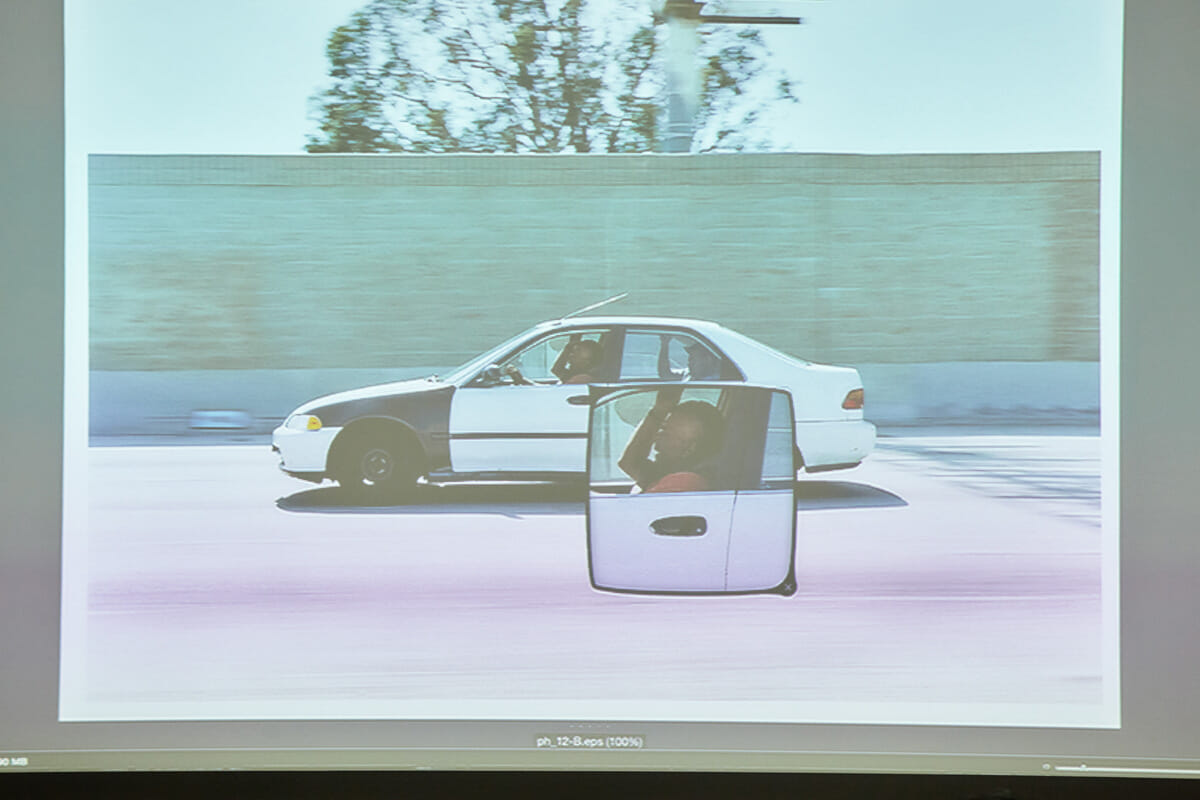
Muraoka:But still, the people on it are interesting.
Plain:Yes! You can faintly see the person on it. I can see more of the original print, but in the photo book, it's a little smudged, but if you look closely, you can see it.
Muraoka:Why is it interesting? . to see people riding.
Plain:I think it may be because they are peeping, but I think it is because they are serious. They are unconscious, too.
Muraoka:. you take pictures of people who are unconscious. . Sometimes I'm told that this is the kind of person who rides in this car. But that's what you wanted to see, wasn't it?
Plain:Yes, it is. You can't see it when you're taking the picture , so you print it and grin.
Muraoka:. before there is a message, there is the fact that it is interesting.
Plain:My barometer is whether or not I can smile when I take a picture and print it. If I am grinning, I know that the photo is interesting and good-looking.
Muraoka:. you were funny in "POOL" too.
Plain:In another way, you had a grin on your face. Pools are hard to shoot, because you don't find good pools very often. So, yay, I shot it! . There was a sense of, "Oh yeah, I got it! . Because of the various conditions, I usually took pictures from an oblique overhead view. Even if I could see the wall of the pool, it was not always a wall I could climb, so I had to carry a big stepladder with me some times. But there were times when the conditions were not right, and when I was able to get a good shot of the pool from a good angle, I was amazed! I would say, "Wow!
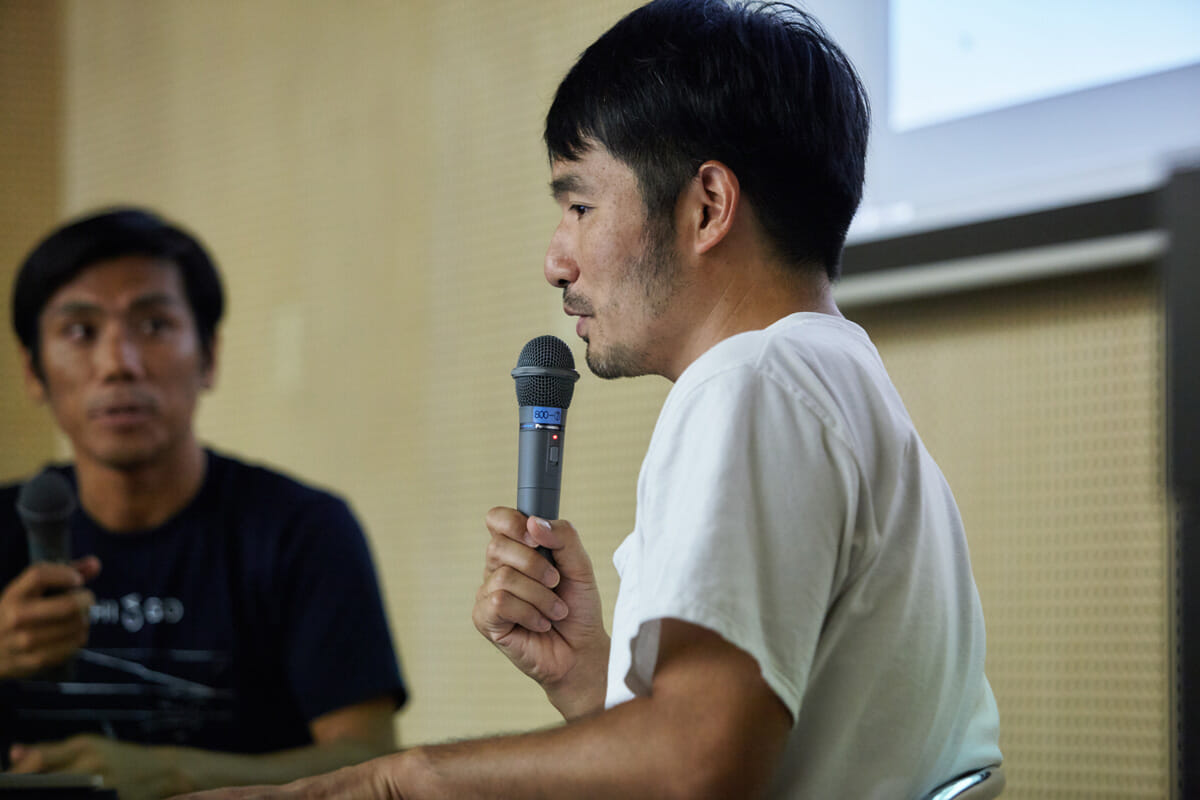
Muraoka:. The fact that it's hard to take pictures is a bit similar.
Plain:I really thought so myself. . there are a lot of cars more interesting than these cars if you look for them parked on the street in a residential area. . like the ones that are so beat up that you can't drive them on the highway anymore. . It would be easier if I parked on the street instead of taking pictures on the highway. But I'm not satisfied if I just look for a parking spot and take a quick shot from the side. That's my habit, or I move my body too, and I miss the shot, or I do it! I think to myself, "I like that I got the shot," or something like that.
Muraoka:Don't you feel like you've taken the picture without a little hard work?
Plain:I wonder why.
Muraoka:For example, as I was listening to him, I was thinking about how it would be if all the parked cars were photographed in the same way, but I thought it would be a little uninteresting for Mr. Taro himself.
Plain:. I think it's because I skateboard. I started skateboarding after spoon-fishing and spent my youth feeling a sense of accomplishment and joy from using my body so much, so maybe I have a habit of feeling a sense of accomplishment when I have mastered a difficult skill after a lot of hard work.
Muraoka:With skateboarding, you have to struggle to find a place, practice practice practice, and make it up, right?
Plain:That's all I'm saying.
Muraoka:Yes, just do it , just do it.
Plain:It's more like self-satisfaction , I did it! . I guess I have a habit of being a bit physical in my photography. . So, I think I have a habit of taking pictures in a physical way, or something like that.
Muraoka:Actually, Taro, since the time of "POOL", people think that you take rather cool and objective pictures. . that although there is no sense of physicality in your photographs, but you are actually taking pictures with your body.
Plain:Oh yeah . Especially "LACC" because I'm already shooting with my torso. . I can't even use a tripod, so I shoot with my inner muscles. I thought I could write a book about that (laughs).
Muraoka:From this point of view, I believe that the essence of photography is in fact physicality, and that Taro's photographs also hide a physicality.

